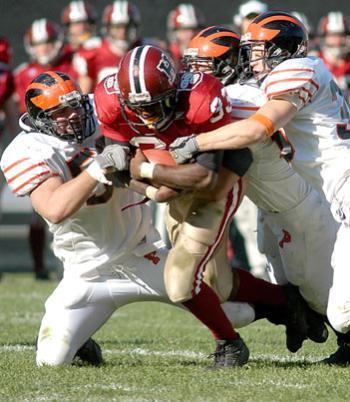Clifton Dawson was never a rookie according to Ivy League rules. Funny, then, that he never played like one either.
Dawson, whose redshirt season at Northwestern and subsequent transfer to Harvard disqualified him from Ivy Rookie of the Year balloting, baffled opposing defenses with his unrivaled combination of power and speed, exploding through holes of his own design and finding open space ever so easily.
“We knew he had a lot of talent when he got here,” said quarterback and incoming captain Ryan Fitzpatrick. “We could tell from the way he carried himself, his body, his speed, his work ethic. We knew he would be the player of the league.”
That he would even approach that level in his first season, however, caught nearly everyone off-guard.
Rushing for an Ivy-freshman record 1,187 yards and 12 touchdowns—both good enough for second in Harvard history behind the sophomore totals of Chris Mennick ’00—Dawson provided a much-needed offensive crutch, particularly after Fitzpatrick fell victim to injuries four games into the season. The record-setting effort also helped Dawson become just the second freshman ever to receive first team All-Ivy honors.
Despite his obvious talent, Harvard coach Tim Murphy had reservations about bringing Dawson into the program without the leverage of a scholarship, for fear that he would use his football skills for admission but never play a down on the field.
“I’m just wary of transfers,” Murphy said. “[Dawson] said, ‘Coach, I want to win and I want to get the best education possible,’ and that was fine. But I’m just not a guy who believes in transfers.”
Despite Murphy’s skepticism, the Scarborough, Ontario native’s intentions proved genuine. And while Murphy worried about the potential pitfalls of taking Dawson on, his future tailback’s stock continued to rise courtesy of the work he put in at Northwestern.
After completing an accelerated courseload, Dawson had graduated high school a semester early and matriculated in the spring, providing him with a much-needed opportunity to cultivate poise reflecting his talent.
“I was a little intimidated, a little scared,” Dawson said. “But I really felt that experience provided me with the mental toughness that allowed me to make the transition with confidence.”
That attitude translated into greater faith in his own natural ability, specifically his capacity to challenge and punish linebackers successfully.
“I definitely did do a lot of those things in high school,” Dawson said. “[But] that aspect of my running style evolved at Northwestern.”
Far from a neophyte when he arrived in Cambridge, Dawson’s expectations echoed those of Fitzpatrick and many of his teammates. Few, though, expected such offensive output in such a short time for the freshman.
Dawson did.
“My expectations were to come in and contribute immediately,” Dawson said. “I know that’s not the typical response from a freshman, but given my experience at Northwestern, I thought I’d be able to come right in and contribute.”
Despite splitting snaps with sophomore Ryan Tyler in three of the season’s first four games—Dawson was suspended from the Brown contest for an unspecified violation of team rules—he showed flashes of brilliance, twice rushing for at least 69 yards on 17 carries. But the best was clearly yet to come.
One week after Fitzpatrick broke his hand, leaving the offense to look for a new sparkplug against Lafayette, Dawson slid gracefully into the top spot on the tailback depth charts and never looked back.
Dawson racked up 218 yards and four touchdowns on 26 carries, highlighted by a 71-yard burst with 2:11 remaining to put the game out of reach.
“He can give us the type of speed threat that we’ve never had here,” Murphy said. “Some of the runs he had against Lafayette and Dartmouth—I’m not sure I’ve seen any back in my 10 years here that could’ve done that.”
The score was Dawson’s third in the game’s final 16:20, a stretch during which he almost single-handedly compensated for the hefty void left by the Crimson’s injured signal caller.
“It was a great opportunity to step up and show what I could do, given the chance to start with the majority of rushes,” Dawson said.
The story followed a similar script against Princeton the following week, with Dawson again taking on the lion’s share of the offensive load. Racking up 183 yards on a whopping 40 carries for three touchdowns, Dawson eased the burden on backup quarterback Garrett Schires as the Crimson battled into overtime.
“I hadn’t [ever had 40 carries],” Dawson said. “In high school, I played the first quarter, maybe the first half, and we’d be up by so much that I wouldn’t be playing anymore.”
Dawson rushed the ball 74 times in the next three weeks, accumulating 435 yards and scoring four times against Dartmouth, Columbia and Penn, despite Harvard’s need to throw the ball late in each contest to make up lost ground.
But Dawson’s best performances came when his production was needed most, and in no case was that truer than against Yale.
With Fitzpatrick hobbled by a torn left meniscus—he attempted only 22 passes on the day—the success of the offense again rested on Dawson’s shoulders. And, to nobody’s surprise, Dawson didn’t stumble.
Grinding out 176 yards on 32 carries, Dawson left only the scoring to anyone else, otherwise carrying the offense the length of the field and back. Even when he was poked in the eye, the freshman took a play off, regained his sight and returned to the huddle.
“For a freshman, boy he was a horse today,” Murphy said.
—Staff writer Timothy J. McGinn can be reached at mcginn@fas.harvard.edu.
Read more in Sports
HEAD OF THE CHARLES '06: The Pressure's On













